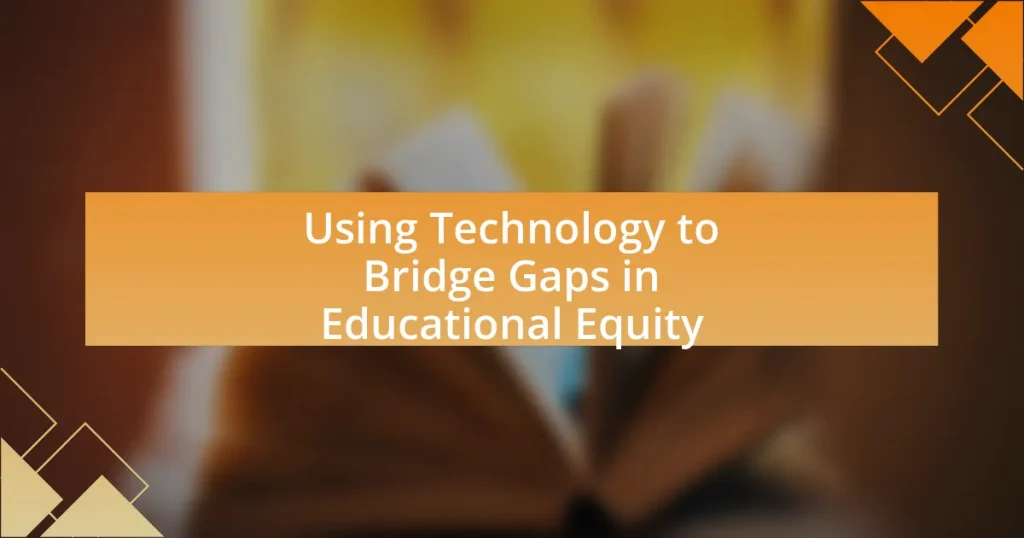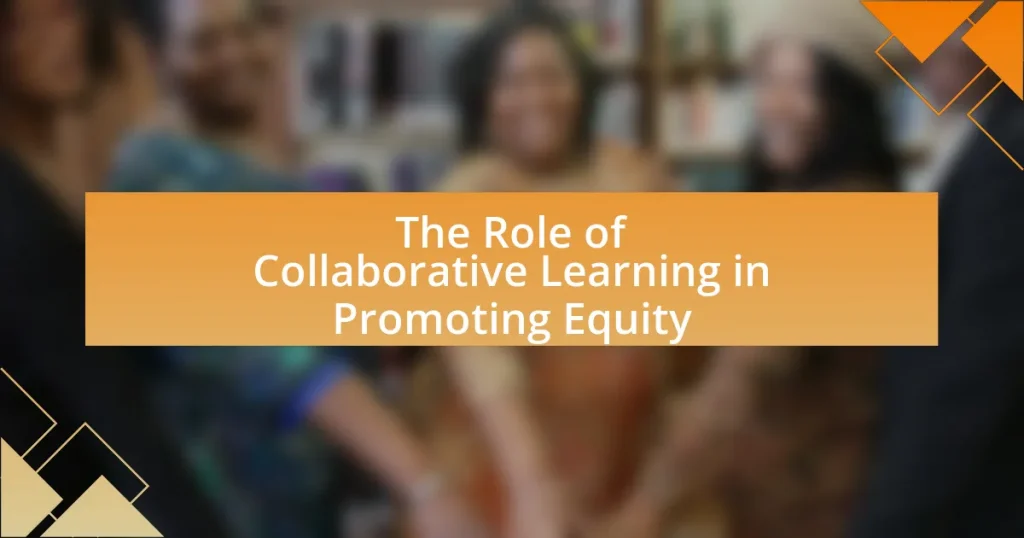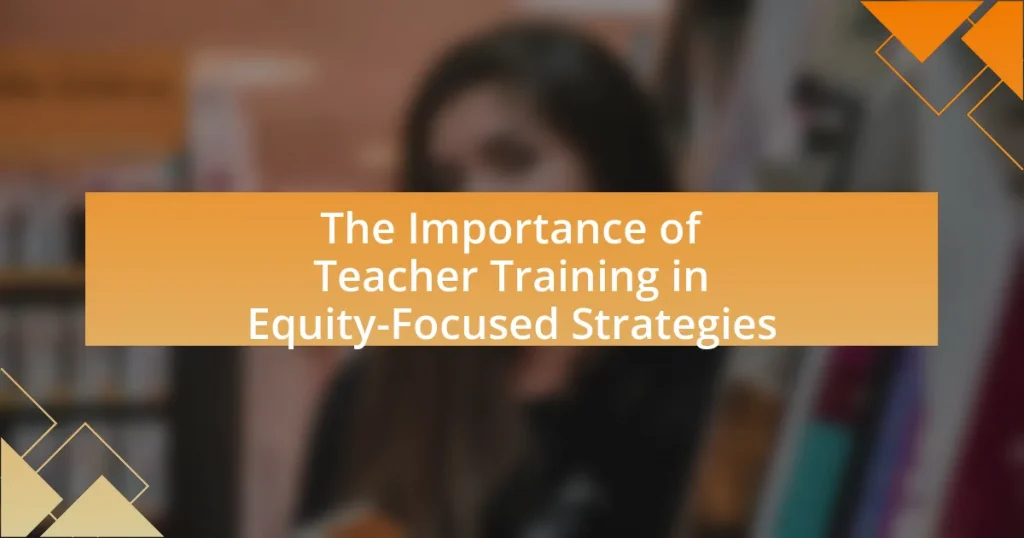Implicit bias in classroom management refers to the unconscious attitudes and stereotypes that educators may hold, influencing their interactions and disciplinary decisions with students. This article examines how implicit bias manifests in educational settings, highlighting its impact on student outcomes, teacher-student relationships, and systemic inequalities. It discusses common examples of bias, strategies for educators to address these biases, and the importance of self-awareness and professional development in fostering an equitable learning environment. Additionally, the article outlines the role of curriculum, community involvement, and school policies in combating implicit bias, providing practical tips and resources for educators seeking to create a more inclusive classroom.
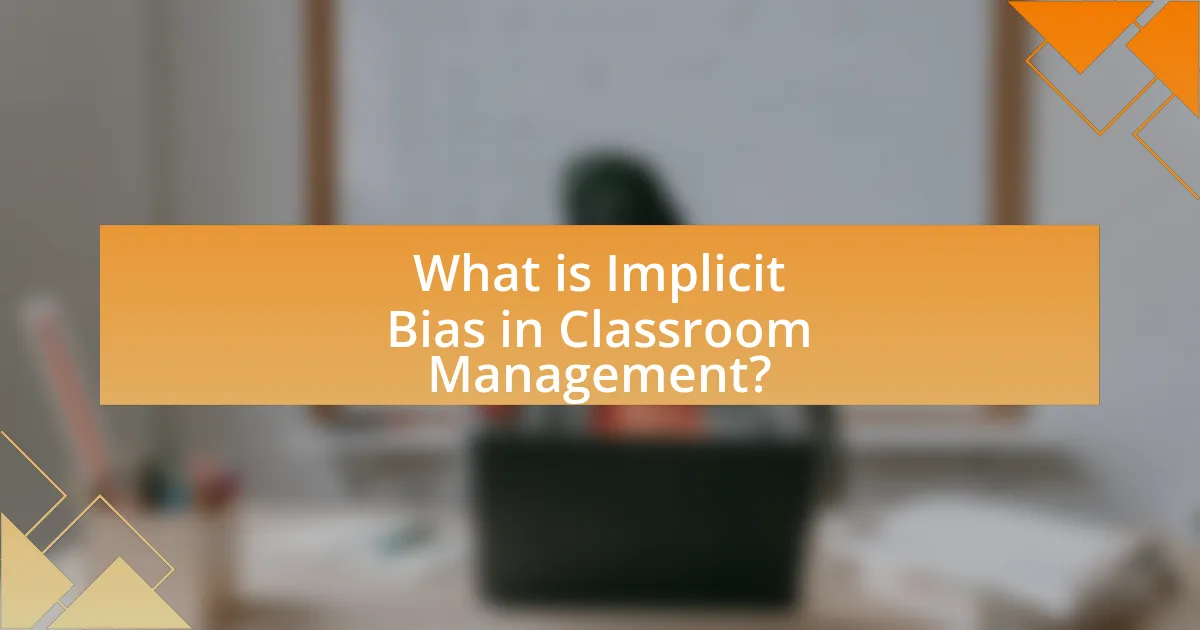
What is Implicit Bias in Classroom Management?
Implicit bias in classroom management refers to the unconscious attitudes or stereotypes that educators hold, which can influence their interactions with students and their disciplinary decisions. Research indicates that these biases can lead to differential treatment of students based on race, gender, or socioeconomic status, affecting academic outcomes and classroom dynamics. For instance, a study published in the journal “Psychological Science” found that teachers may unknowingly hold lower expectations for students of color, which can result in a self-fulfilling prophecy where those students perform worse academically.
How does implicit bias manifest in educational settings?
Implicit bias manifests in educational settings through differential treatment of students based on race, gender, or socioeconomic status. Educators may unconsciously hold lower expectations for certain groups, leading to disparities in academic support and disciplinary actions. For instance, research indicates that Black students are more likely to be suspended or expelled than their white peers for similar behaviors, highlighting a systemic bias in disciplinary measures. Additionally, implicit bias can influence classroom interactions, where teachers may call on or engage with students differently based on preconceived notions, affecting student participation and learning outcomes.
What are common examples of implicit bias in classroom interactions?
Common examples of implicit bias in classroom interactions include differential treatment of students based on race, gender, or socioeconomic status. For instance, teachers may unconsciously call on boys more frequently than girls, reinforcing gender stereotypes. Research shows that teachers often have lower expectations for students of color, which can lead to a lack of encouragement and support for these students. Additionally, implicit bias can manifest in disciplinary actions, where minority students may face harsher consequences for similar behaviors compared to their white peers. These biases can significantly impact student engagement and academic performance, as highlighted in studies such as “The Impact of Implicit Bias on Student Outcomes” by the American Psychological Association.
How does implicit bias affect teacher-student relationships?
Implicit bias negatively impacts teacher-student relationships by influencing teachers’ perceptions and interactions with students based on stereotypes rather than individual merit. Research indicates that teachers may unconsciously favor certain students over others, leading to disparities in attention, feedback, and support. For example, a study published in the journal “Social Psychological and Personality Science” found that teachers’ implicit biases can result in lower expectations for students from marginalized backgrounds, which in turn affects students’ academic performance and self-esteem. This cycle of bias can create an environment where students feel undervalued and disengaged, ultimately hindering their educational experience.
Why is addressing implicit bias important in education?
Addressing implicit bias is important in education because it directly impacts student outcomes and equity in learning environments. Implicit biases can lead to unfair treatment of students based on race, gender, or socioeconomic status, which can hinder their academic performance and emotional well-being. Research indicates that teachers’ implicit biases can influence their expectations and interactions with students, ultimately affecting students’ self-esteem and engagement. For instance, a study published in the journal “Psychological Science” found that teachers’ biases can result in lower academic performance among marginalized students, demonstrating the need for educators to recognize and mitigate these biases to foster an inclusive and supportive educational atmosphere.
What impact does implicit bias have on student outcomes?
Implicit bias negatively impacts student outcomes by influencing teachers’ perceptions and interactions with students, leading to disparities in academic performance and disciplinary actions. Research indicates that teachers may unconsciously hold lower expectations for students from marginalized backgrounds, which can result in reduced opportunities for engagement and support. For instance, a study published in the journal “Psychological Science” found that teachers’ implicit biases can affect their grading practices, contributing to achievement gaps. Additionally, biased disciplinary measures can disproportionately affect students of color, resulting in higher suspension and expulsion rates, which further hinders their educational progress.
How can implicit bias contribute to systemic inequalities in schools?
Implicit bias can contribute to systemic inequalities in schools by influencing educators’ perceptions and interactions with students based on race, gender, or socioeconomic status. Research indicates that teachers may unconsciously hold lower expectations for certain groups of students, leading to disparities in academic support and disciplinary actions. For instance, a study published in the journal “Psychological Science” found that teachers were more likely to perceive Black students as troublemakers, which resulted in harsher disciplinary measures compared to their white peers. This bias not only affects individual student outcomes but also perpetuates a cycle of disadvantage that reinforces existing inequalities within the educational system.
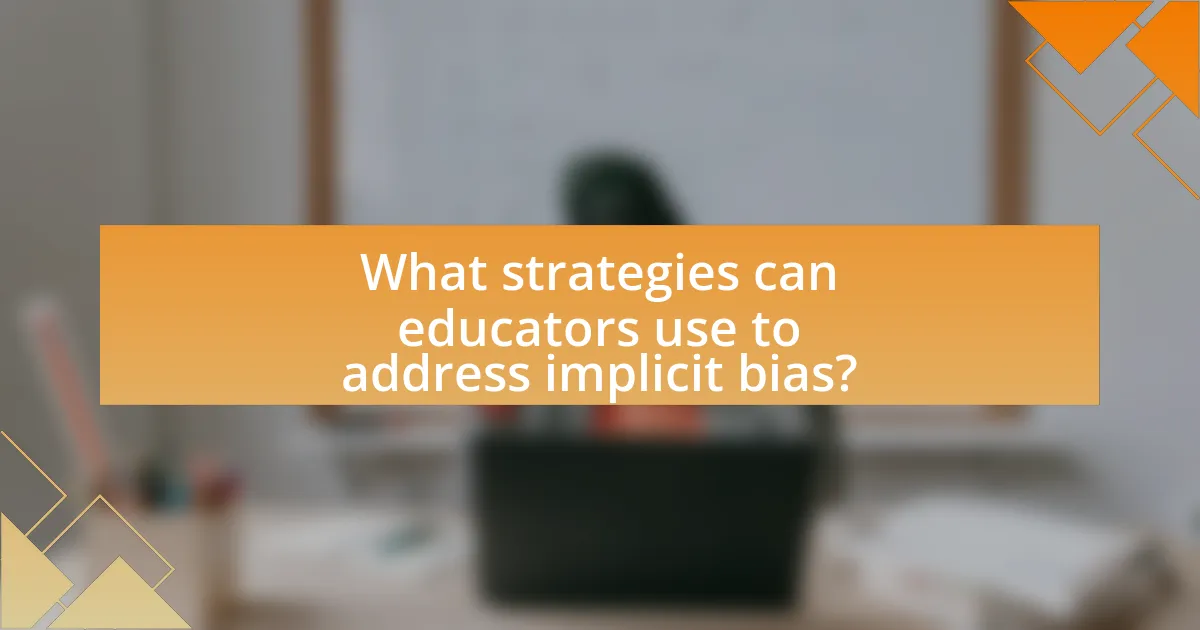
What strategies can educators use to address implicit bias?
Educators can address implicit bias by implementing strategies such as training on cultural competency, utilizing diverse teaching materials, and fostering an inclusive classroom environment. Cultural competency training equips educators with the skills to recognize and mitigate their biases, as studies show that awareness of implicit bias can lead to more equitable teaching practices. Incorporating diverse teaching materials ensures that all students see themselves represented in the curriculum, which can enhance engagement and reduce bias. Additionally, creating an inclusive classroom environment encourages open dialogue about bias and promotes respect among students, further reducing the impact of implicit bias on classroom management.
How can self-awareness help in mitigating implicit bias?
Self-awareness can significantly mitigate implicit bias by enabling individuals to recognize their own biases and understand how these biases influence their perceptions and behaviors. When educators develop self-awareness, they can identify automatic thoughts and reactions that may stem from stereotypes or preconceived notions. Research indicates that self-reflection practices, such as mindfulness and critical self-examination, can lead to a reduction in biased decision-making. For instance, a study published in the Journal of Educational Psychology found that teachers who engaged in self-reflective practices demonstrated improved equity in their classroom interactions, thereby reducing instances of biased treatment towards students from diverse backgrounds. This evidence underscores the importance of self-awareness in fostering an inclusive educational environment.
What techniques can teachers use to reflect on their biases?
Teachers can use techniques such as self-reflection journals, peer feedback, and professional development workshops to reflect on their biases. Self-reflection journals allow educators to document their thoughts and feelings about classroom interactions, helping them identify patterns of bias. Peer feedback provides an opportunity for colleagues to observe and discuss teaching practices, offering insights into potential biases that may not be apparent to the individual teacher. Professional development workshops focused on diversity and inclusion equip teachers with the knowledge and tools to recognize and address their biases effectively. Research indicates that these reflective practices can lead to improved awareness and changes in behavior, ultimately fostering a more equitable classroom environment.
How does professional development play a role in bias awareness?
Professional development enhances bias awareness by equipping educators with the knowledge and skills to recognize and address their own implicit biases. Training programs often include workshops and seminars that focus on understanding the nature of bias, its impact on student interactions, and strategies for creating equitable classroom environments. Research indicates that educators who participate in bias awareness training demonstrate improved attitudes towards diversity and are more likely to implement inclusive practices in their teaching. For instance, a study published in the Journal of Educational Psychology found that teachers who underwent professional development focused on bias awareness reported a significant decrease in biased behaviors and an increase in culturally responsive teaching methods.
What role does curriculum play in addressing implicit bias?
Curriculum plays a crucial role in addressing implicit bias by integrating diverse perspectives and promoting critical thinking among students. By incorporating materials that reflect various cultures, histories, and experiences, the curriculum can challenge stereotypes and foster an inclusive environment. Research indicates that when students engage with content that represents multiple viewpoints, they are more likely to develop empathy and understanding, which can mitigate the effects of implicit bias. For instance, studies have shown that curricula emphasizing social justice and equity can lead to improved attitudes and behaviors towards marginalized groups, thereby reducing bias in classroom interactions.
How can inclusive teaching materials reduce bias?
Inclusive teaching materials can reduce bias by representing diverse perspectives and experiences, which fosters an environment of understanding and respect. When educational resources include varied cultural, racial, and gender representations, they challenge stereotypes and promote empathy among students. Research indicates that exposure to inclusive content can enhance students’ critical thinking and reduce prejudiced attitudes, as demonstrated in studies like “The Impact of Culturally Relevant Teaching on Student Engagement” by Ladson-Billings, which shows that students perform better and exhibit less bias when they see themselves reflected in their learning materials.
What are effective practices for promoting diversity in classroom discussions?
Effective practices for promoting diversity in classroom discussions include implementing structured dialogue techniques, encouraging diverse perspectives, and fostering an inclusive environment. Structured dialogue techniques, such as think-pair-share or fishbowl discussions, allow all students to participate and share their viewpoints, ensuring that voices from various backgrounds are heard. Encouraging diverse perspectives involves actively inviting contributions from students of different races, genders, and socioeconomic statuses, which can enhance the richness of the discussion. Fostering an inclusive environment requires educators to establish ground rules that promote respect and openness, thereby reducing the impact of implicit bias and creating a safe space for all students to express their thoughts. Research indicates that classrooms that prioritize diverse discussions lead to improved critical thinking and empathy among students, as highlighted in studies by the American Educational Research Association.
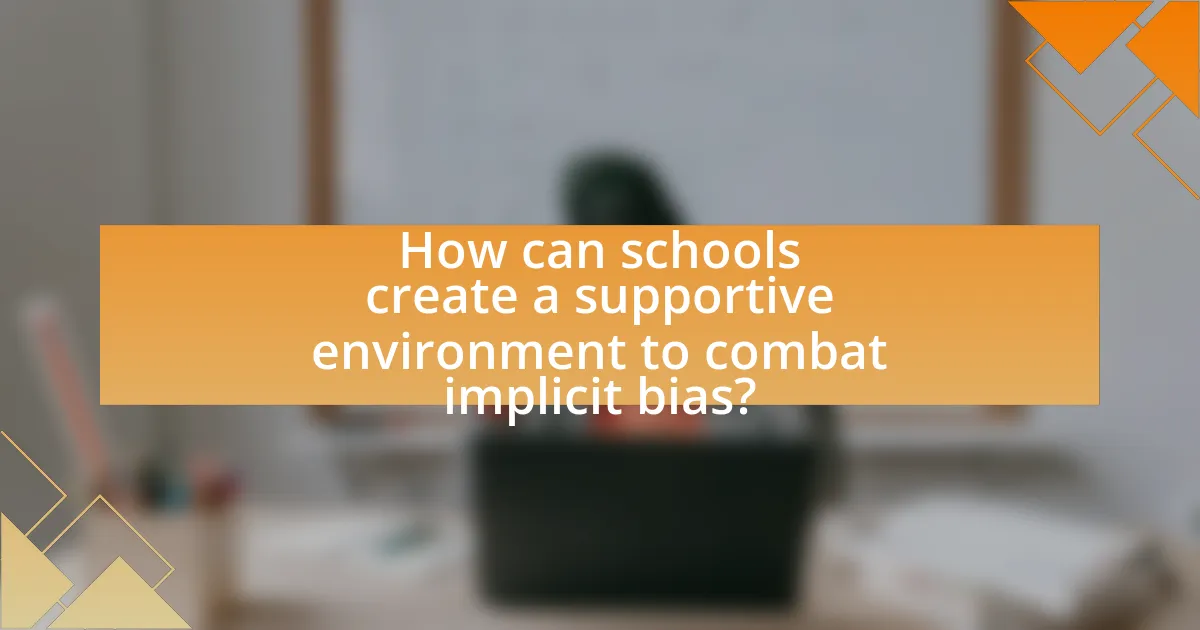
How can schools create a supportive environment to combat implicit bias?
Schools can create a supportive environment to combat implicit bias by implementing comprehensive training programs for educators that focus on recognizing and addressing their own biases. Research indicates that professional development initiatives, such as those outlined in the “Implicit Bias Training for Educators” study by the Kirwan Institute for the Study of Race and Ethnicity, can significantly enhance teachers’ awareness of their biases and improve classroom interactions. Additionally, fostering an inclusive curriculum that reflects diverse perspectives and experiences helps students feel valued and understood, further mitigating the effects of bias. Schools can also establish clear policies and practices that promote equity and accountability, ensuring that all students receive fair treatment regardless of their background.
What policies can schools implement to address implicit bias?
Schools can implement training programs focused on implicit bias awareness for educators and staff. These programs educate personnel about their own biases and how these biases can affect student interactions and outcomes. Research indicates that training can lead to improved teacher-student relationships and equitable treatment of all students, as evidenced by a study published in the Journal of Educational Psychology, which found that teachers who underwent implicit bias training showed a significant reduction in biased disciplinary actions. Additionally, schools can adopt policies that promote diverse hiring practices to ensure a more representative faculty, which has been shown to positively influence student achievement and engagement, particularly among minority students. Implementing regular assessments of disciplinary actions and academic outcomes can also help identify and address disparities linked to implicit bias, fostering a more equitable educational environment.
How can school leadership foster a culture of equity?
School leadership can foster a culture of equity by implementing policies and practices that actively promote inclusivity and address implicit biases. Effective leaders prioritize professional development focused on equity, ensuring that all staff understand and recognize their own biases, which can influence classroom management and student interactions. Research indicates that schools with strong equity-focused leadership see improved student outcomes, particularly among marginalized groups, as these leaders create an environment where diverse perspectives are valued and integrated into the curriculum. For instance, a study by the National Equity Project highlights that schools led by equity-minded leaders report higher levels of student engagement and achievement, demonstrating the positive impact of such leadership on fostering an equitable school culture.
What role do parents and the community play in addressing bias?
Parents and the community play a crucial role in addressing bias by fostering an inclusive environment and promoting awareness. Parents can educate their children about diversity and the importance of equity, while community organizations can provide resources and training to help individuals recognize and combat bias. Research indicates that when parents engage in discussions about bias and model inclusive behaviors, children are more likely to adopt these values, leading to a reduction in biased attitudes and behaviors. Additionally, community initiatives that involve workshops and outreach programs can effectively raise awareness and provide strategies for addressing bias in educational settings.
What are some practical tips for educators to reduce implicit bias in their classrooms?
Educators can reduce implicit bias in their classrooms by implementing structured training on cultural competency and bias awareness. Research indicates that professional development focused on these areas can significantly enhance teachers’ understanding of their own biases and improve student interactions (Gorski, 2016). Additionally, educators should utilize diverse teaching materials that reflect a variety of cultures and perspectives, which has been shown to foster an inclusive environment and promote equity in learning (Ladson-Billings, 1994). Regularly reflecting on classroom practices and seeking feedback from peers can also help educators identify and address any biases in their teaching methods.
How can teachers implement bias-reducing strategies in daily practices?
Teachers can implement bias-reducing strategies in daily practices by incorporating structured reflection and diverse instructional materials. Structured reflection allows teachers to examine their own biases and assumptions, which can be facilitated through regular self-assessment and peer feedback sessions. Research indicates that self-reflection can significantly reduce implicit biases, as shown in studies like “Reducing Implicit Bias: A Review of the Literature” by Devine et al., which highlights the effectiveness of reflective practices in educational settings. Additionally, using diverse instructional materials that represent various cultures and perspectives helps create an inclusive environment, fostering empathy and understanding among students. This approach not only addresses bias but also enhances student engagement and learning outcomes.
What resources are available for educators seeking to learn more about implicit bias?
Educators seeking to learn more about implicit bias can access a variety of resources, including online courses, workshops, and literature. The Kirwan Institute for the Study of Race and Ethnicity offers comprehensive training materials and research on implicit bias, while the American Psychological Association provides guidelines and resources for educators. Additionally, the book “Blindspot: The Hidden Biases of Good People” by Mahzarin R. Banaji and Anthony G. Greenwald serves as a foundational text on the subject. These resources are designed to enhance understanding and provide practical strategies for addressing implicit bias in educational settings.

